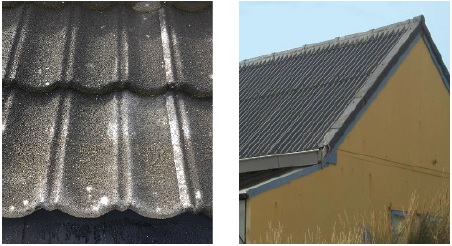This safety alert highlights the serious health and safety risks of using high-pressure water blasting to clean roofing and cladding that contain asbestos.
What has happened
WorkSafe New Zealand has become aware of painting contractors using high-pressure water blasting to clean
asbestos-containing roofing material in preparation for painting. In New Zealand, there are many commercial buildings and residential houses which have roofing and cladding materials containing asbestos.

What we know
High-pressure water blasting can disturb asbestos fibres in the roofing or cladding and spread them throughout the environment. When the fibres become airborne, they can be inhaled by workers and others, which can result in asbestos-related diseases.
High-pressure water blasting (pressure greater than 350kPA or 50PSI) must not be used to clean asbestos-containing material. Under the Health and Safety at Work (Asbestos) Regulations 2016, an individual or business can be infringed up to $9000 or upon conviction in court can be fined up to $30,000 for using high-pressure water spray or compressed air on asbestos containing materials.
A business which contaminates a site with asbestos-containing material may also be liable for the site cleanup costs by licensed asbestos removalists. This is in addition to any fines issued by WorkSafe.
An alternative to high-pressure water blasting is to use a ‘soft wash’ option or chemical wash. A broom must not be used on asbestos as this will release the asbestos fibres.
What you must do
Before you do any work, find out if there is asbestos in any of the roofing or cladding material that you intend to work on. One way to do this is by engaging a competent person to conduct an asbestos survey.
Other ways to identify if asbestos is present is to check building plans, Land Information Memorandum (LIM) reports or arrange a sample to be taken by a competent person and tested by an IANZ accredited laboratory.
Both the Health and Safety at Work Act 2015 and the Health and Safety at Work (Asbestos) Regulations 2016 place a duty on employers, contractors, workers, and others to work together to ensure that any work carried out is done safely. Workers and contractors should be involved in health and safety discussions about managing the risks of the work being done.
The Health and Safety at Work (Asbestos) Regulations 2016 prohibits the use of high-pressure water spray and compressed air on asbestos. The Regulations also require those with asbestos in their workplace to develop an asbestos management plan and manage it safely.
Property owners, project managers, property managers, facilities managers, landlords and contractors need to identify if buildings contain asbestos or asbestos containing material so they can record these details and management controls in an asbestos management plan to safely manage the asbestos.
The asbestos management plan should include the details about the type of asbestos, the location and management controls in place, to prevent people from being exposed to asbestos. The plan must be available to those who need to know, such as project planners, contractors, and workers.
If asbestos-containing material is damaged or is showing signs of disrepair, it should be a priority for removal using a licensed asbestos removalist.
The asbestos management plan must be accessible to those who need to know, particularly project planners, contractors, and workers.
Note: Homeowners who occupy and live in the dwelling where work is taking place do not have a duty under the Health and Safety at Work Act 2015. The duty lies with those doing the work on the dwelling, and a business owning or managing the property, which means asbestos needs to be identified and managed safely. This places the duty on the PCBU doing the work to ensure that asbestos is identified and managed safely.
Further guidance
Managing health and safety
Overlapping duties
Asbestos management plans
Working with asbestos
Residential landlords
Download
Last updated